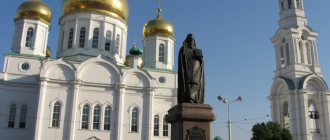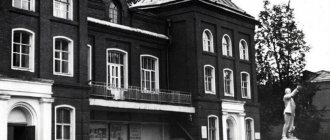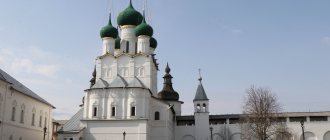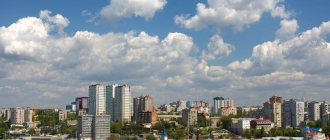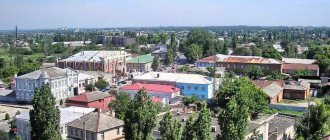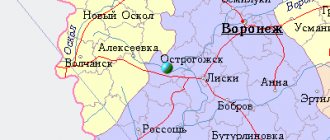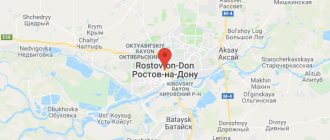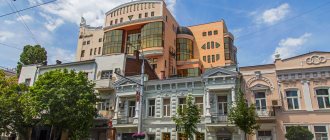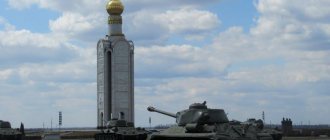The Rostov region is the homeland of the Cossacks and the land of the steppes, stretching along the banks of the mighty Don. The region, from which the hot southern territories of Russia begin, is in sixth place in the country in terms of population: according to 2022 information, 4,203,634 live here. In terms of size, the region is “in the middle”: the area is 100,967 km², which puts it at 33 position of the all-Russian rating. The Saratov region has approximately the same area, 23 times more in the Krasnoyarsk Territory and 27 times less in the Republic of Ingushetia. Since 1998, the population of the region has been steadily decreasing: over 20 years the drop was 285,000 people.
The largest cities in the Rostov region
There are only 23 cities in the Rostov region, but unlike many other regions, a significant part are quite large. Seven have a population of 100,000 people or more; less than 20,000 inhabitants are recorded in only four cities. Their area is also quite significant: 9 settlements have an area of more than 100 km².
The ratio of the size and number of inhabitants of cities is approximately the same: 8 are in the top 10 for both indicators. The undisputed leader of the ratings is the capital of the region, the largest settlement in the region and the real metropolis of Rostov-on-Don with indicators of 348.5 km² and 1,130,305 people. However, there are also surprises: Taganrog, which is in second place in terms of population, is only in tenth place in terms of area. And Konstantinovsk, which is in second place among the smallest in terms of the number of residents, is again in second position, but already in the category of largest in size.
The largest cities in the Rostov region include (value in km²):
- Rostov-on-Don - 348.5.
- Konstantinovsk - 298.
- Volgodonsk - 182.3.
- Kamensk-Shakhtinsky - 160.
- Mines - 158.2.
- Semikarakorsk - 140.
- Novoshakhtinsk - 136.
- Novocherkassk - 128.
- Donetsk - 112.
- Taganrog - 95.
Rostov-on-Don is the main metropolis of southern Russia
“Rostov-Papa” is the largest settlement not only in the Rostov region, but also in the entire south of the country, the tenth largest city in the Russian Federation by population and the only million-plus region with a population of 1,130,305. If we take into account the Rostov-Shakhtinsk urban agglomeration, the numbers are even more impressive: 2.16 million people and fourth place in the all-Russian ranking. The city crossed the million barrier back in 1987, but then, until 2008, the number fell steadily: in 2001 it even reached the figure of 997,800 people. However, in the last decade the figure has been increasing: it has grown by almost 100,000. The main role is played by migration from other regions and small settlements in the region. In this regard, housing construction has been actively carried out in recent years.
The area of the southern capital is also quite significant: 348.5 km². For comparison, St. Petersburg is 4 times larger, Moscow is 7 times larger, and Ekaterinburg is only 120 km² ahead. The population density is high - 3243.34: almost the same as in St. Petersburg with an indicator of 3835.88. This situation provokes problems typical for any metropolis. The main problem is traffic jams, which are especially serious in the historical and business districts. In the summer, when the hot climate makes itself felt, the suffocating exhaust of automobile gases increases: 94% of the total level of air pollution comes from them. Rail transport and the activities of industrial enterprises also cause harm to the environment: the latter pollute not only the air, but also water bodies and soil. The problem is outdated treatment equipment, as well as ongoing utility problems. For example, about 13% of the city's territory is not equipped with sewerage communications.
At the same time, about 35% of Rostov is covered with green spaces, amounting to as much as 244% of the minimum share recommended for large cities. The city authorities and residents try to keep the streets clean and the facades updated in a timely manner, so it’s pleasant to walk along the central streets at any time of the year. The majestic Don also flows here, and within the city limits there are about 15 reservoirs, near which it is pleasant to cool off and spend time on hot summer days.
Rostov is one of the most important economic and industrial centers. There are about 30 large enterprises, many of which are known throughout Russia:
- "Gloria Jeans" - production of youth clothing;
- Donskoy Tabak is one of the largest tobacco factories in the country;
- “Rostselmash” - thanks to the company, Rostov-on-Don is known as the “capital of combine harvesters”, since it is here that they and other agricultural equipment are produced;
- "Rostvertol" - the highest significance is determined by the fact that it is the only company of its kind producing helicopters in the Russian Federation.
It is also not for nothing that Rostov is called the “Gateway of the Caucasus”: its logistical significance is great, since the city connects the south, the Caucasus and the center of Russia.
At the end of the year, Rostov entered the top 10 cities in terms of management efficiency
At the end of the year, Rostov entered the ranking of the best cities in Russia in terms of management efficiency, taking an honorable sixth place out of 92 possible. Head of Administration Alexey Logvinenko announced this on his Instagram page on December 22. The annual top was compiled by the agency of political and economic communications. The list for the study included all the capitals of Russian regions, with the exception of settlements of federal significance. Large cities that are not regional centers and are home to more than 300 thousand people were also taken into account.
— The effectiveness of city management was assessed according to criteria that are divided into two blocks: political-managerial and socio-economic. More than 200 experts took part in assessing the effectiveness of management in urban districts - political scientists, sociologists, scientists, journalists, urbanists, political strategists and public figures,” Logvinenko noted.
Thus, experts assessed the results of the September elections to the State Duma, expenditures on national needs in the local budget, the share of children under six years of age receiving educational services, the number of places in kindergartens, as well as budget expenditures on culture and housing and communal services.
Tyumen became the leader of the rating. Next come Salekhard, Grozny, Kazan and Khanty-Mansiysk.
204 experts took part in assessing the effectiveness of management in urban districts. According to the compilers of the rating, when making the assessment, their opinions and the current socio-political and socio-economic situation in urban districts, directly or indirectly related to the activities of city authorities, were taken into account.
For each of the two blocks that make up the final assessment, its own rating is calculated. It is obtained by averaging the assessments of regions in several directions within a block.
The final grades for each direction within the block represent the arithmetic mean of: a) the average set of standardized statistical indicators and b) the average expert assessment. This approach allows us to minimize the impact of the problem of incomplete and somewhat outdated information, which in some cases had to be used in the rating. Thus, expert assessments are of great importance for the reason that they relate directly to the period under study and to the assessment of the work of the city government. Budget statistics relate to the same period. At the same time, most statistical indicators are still available only for 2020.
Konstantinovsk is large in area, but modest in number
Konstantinovsk surprisingly takes second place in the list of largest cities. Only 17,317 people live here, which puts it in second place in terms of population. The area can be compared with Rostov and is 298 km². It also stands on the Don, but is located 169 km from the capital. It was founded in 1593 and was called the village of Babskaya. Some researchers explain the unusual name by the devotion of the wives of local Cossacks, and others by the fact that an unusual subspecies of pelicans lived in these parts, which were called the “woman bird.”
The real development of Konstantinovsk began much later. In the fifties, the construction of the Volga-Don Canal, intended for large-scale shipping, was completed; one of the piers was located on the lands of a small settlement. It began to grow rapidly and in 1967 earned city status. The town's manufacturing sector is poorly developed and is represented by small private companies. The leading role belongs to agriculture: sunflower and grain crops are cultivated.
III. Photo gallery
The same dacha of ex-governor Vladimir Chub in Yantarny - if you believe local rumors.
"Amber": general panorama.
Developed construction in the cottage village "Izumrudny" - a new "version" of "Yantarny".
Panorama of the first street, Rostovskaya, that opened in the Donskaya suburb.
The Rostov cottage community “Donskoy” is the most strict in terms of adherence to the architectural concept. Even fences are part of the overall appearance. These are its pros and cons: the buyer moves into a beautiful environment and ready-made housing, but as a result, you will no longer be able to take any “liberties” here.
Construction of Azovskaya Street in Donskoy.
In "Solnechny".
Traffic jams on one of the roads to Shchepkin.
Some developers “north of Orbitalnaya” began to position their real estate as cottage villages, which have nothing to do with them.
"Belovodye": this is how it all began.
The Transfiguration Church is the main architectural landmark of the Obukhovka farm and a dominant feature in the surrounding area.
Notes:
- Website of the cottage village "Izumrudny".
- “Norald Nersesyants: “It’s time to unite Rostov with Aksai and Bataysk” // “Vestnik. Construction. Architecture. Infrastructure" No. 1 2007
- Real estate sellers about the bad influence of the Northern Bypass/“Cottages by the Bypass”//City N, October 2, 2012
- Belovodye Village Forum
Volgodonsk is the capital of the nuclear industry
Volgodonsk is a fairly large city in terms of basic indicators: it is in fourth place in terms of population and third in size. Its geographical position is unique: in close proximity there are two million-plus people: the hero city of Volgograd and the city of military glory Rostov-on-Don. A little further, but still quite close, there are other large cities: Kalmyk Elista, as well as Stavropol and Krasnodar. The location and subsequent numerous all-Union construction projects included Volgodonsk among the most multinational cities in Russia: representatives of 87 nationalities live here.
The settlement owes its appearance, development and even name to one of the most ambitious Soviet construction projects: the connection of the Volga and Don. In the post-war period, thousands of people began to flock to the small village of Tsimlyanskaya, which gave its name to the future reservoir, for whom a workers’ settlement was founded. The construction did not end: one after another, a chemical plant, a thermal power plant, residential areas appeared, and in the seventies, one of the main enterprises of the region - Atommash and the Rostov Nuclear Power Plant. The dynamically developing city shows good economic indicators: the quality of life of citizens, the state of public utilities, the social sphere, and the provision of retail space are increasing annually.

